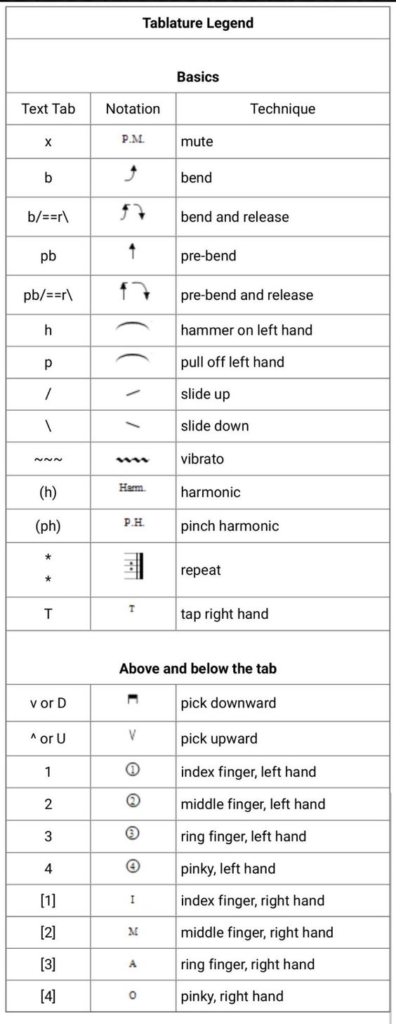For guitarists, especially beginners, learning to read guitar tablature (tabs) is a crucial skill that unlocks the ability to play countless songs. Tabs are a simplified notation system that provides a visual representation of the guitar fretboard, showing where to place your fingers to play notes and chords. This guide will take you through the basics of reading guitar tabs and provide tips for mastering this essential skill.


Understanding the Basics of Guitar Tabs:


- The Layout:
- Guitar tabs consist of six horizontal lines, each representing one of the guitar strings. The bottom line corresponds to the low E string (6th string), and the top line corresponds to the high E string (1st string).
e|----------------|
B|----------------|
G|----------------|
D|----------------|
A|----------------|
E|----------------|- Fret Numbers:
- Numbers placed on the lines indicate which fret to press on the corresponding string. For example, a “3” on the bottom line means you should press the third fret of the low E string.
e|----------------|
B|----------------|
G|----------------|
D|----------------|
A|----------------|
E|-----3----------|- Zero (0):
- A “0” indicates an open string, meaning you play the string without pressing any fret.
e|----------------|
B|----------------|
G|----------------|
D|----------------|
A|-------0--------|
E|-----3----------|- Multiple Numbers:
- Numbers stacked vertically indicate that these notes should be played simultaneously, forming a chord.
e|---0------------|
B|---1------------|
G|---0------------|
D|---2------------|
A|---3------------|
E|----------------|Common Symbols and Techniques in Tabs:
- Hammer-Ons (h):
- Indicated by an “h” between two numbers, a hammer-on means you pluck the first note and then hammer your finger onto the second fret without plucking again.
e|----------------|
B|---5h7----------|
G|----------------|
D|----------------|
A|----------------|
E|----------------|- Pull-Offs (p):
- Indicated by a “p” between two numbers, a pull-off means you pluck the first note and then pull your finger off to let the second note ring.
e|----------------|
B|---7p5----------|
G|----------------|
D|----------------|
A|----------------|
E|----------------|- Slides (/ or ):
- A forward slash (/) indicates a slide up to a higher note, while a backslash () indicates a slide down to a lower note.
e|----------------|
B|---5/7----------|
G|----------------|
D|----------------|
A|----------------|
E|----------------|- Bends (b):
- Indicated by a “b,” bends involve pushing the string up or down to reach a higher pitch. The number after the “b” indicates how many frets to bend up.
e|----------------|
B|---7b9----------|
G|----------------|
D|----------------|
A|----------------|
E|----------------|- Vibrato (~):
- Represented by a tilde (~), vibrato involves rapidly bending and releasing the string to create a quivering effect.
e|----------------|
B|---7~-----------|
G|----------------|
D|----------------|
A|----------------|
E|----------------|- Palm Muting (PM):
- Indicated by “PM” above the tab with a series of dashes, palm muting involves resting the side of your picking hand on the strings near the bridge to create a muted sound.
e|----------------|
B|----------------|
G|----------------|
D|----------------|
A|---3-3-3-3------|
E|---3-3-3-3------|
PM-------Tips for Reading Tabs Effectively:
- Start Slow:
- Begin by practicing simple songs and riffs to get comfortable with reading tabs. Focus on accuracy and timing before increasing speed.
- Use a Metronome:
- A metronome can help you keep time and ensure that you’re playing the notes and rhythms correctly.
- Break It Down:
- Divide the song into smaller sections and practice each part individually before putting it all together.
- Listen and Play Along:
- Listen to the original recording of the song to understand the rhythm, phrasing, and dynamics. Play along with the recording to match your timing and feel.
- Practice Regularly:
- Consistent practice is key to improving your tab reading skills. Set aside dedicated time each day to work on reading and playing tabs.
Conclusion:
Reading guitar tabs is a valuable skill that opens up a world of musical possibilities. By understanding the basics and practicing regularly, you’ll quickly become proficient at interpreting tabs and playing your favorite songs. Remember to start slow, use a metronome, and break down complex sections into manageable parts. With dedication and practice, you’ll be able to master the art of reading guitar tabs and bring your music to life. Happy playing!





